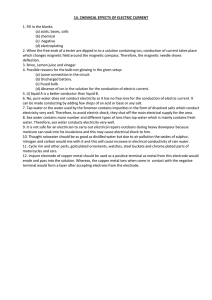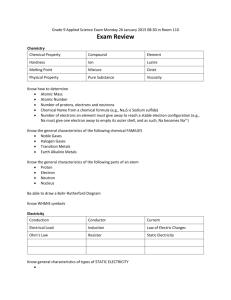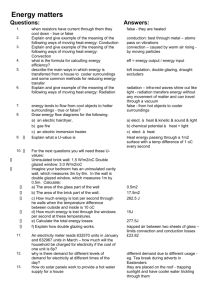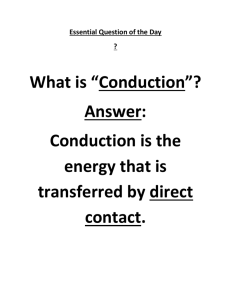Horizontal Lesson Planning Template
advertisement
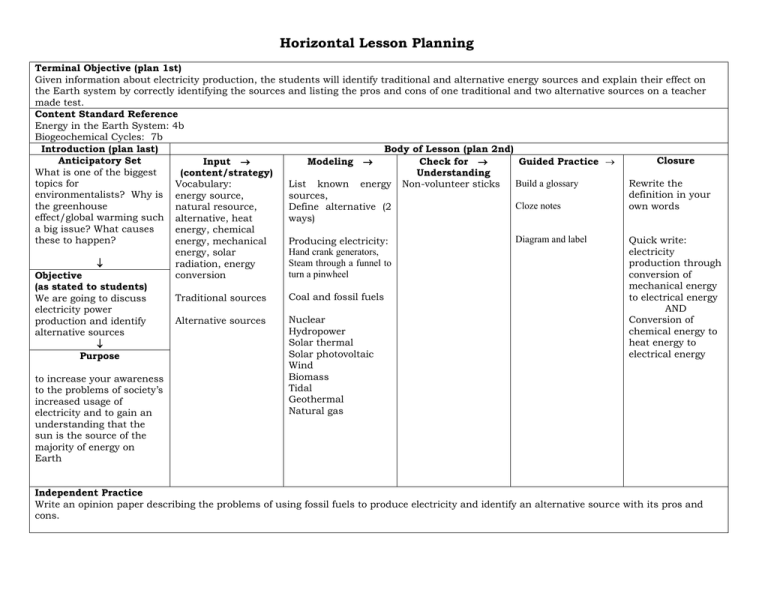
Horizontal Lesson Planning Terminal Objective (plan 1st) Given information about electricity production, the students will identify traditional and alternative energy sources and explain their effect on the Earth system by correctly identifying the sources and listing the pros and cons of one traditional and two alternative sources on a teacher made test. Content Standard Reference Energy in the Earth System: 4b Biogeochemical Cycles: 7b Introduction (plan last) Body of Lesson (plan 2nd) Anticipatory Set Closure Input Modeling Check for Guided Practice What is one of the biggest (content/strategy) Understanding topics for Build a glossary Rewrite the Vocabulary: List known energy Non-volunteer sticks environmentalists? Why is energy source, definition in your sources, Cloze notes the greenhouse own words natural resource, Define alternative (2 effect/global warming such alternative, heat ways) a big issue? What causes energy, chemical Diagram and label these to happen? Quick write: energy, mechanical Producing electricity: electricity Hand crank generators, energy, solar production through Steam through a funnel to radiation, energy turn a pinwheel conversion of conversion Objective mechanical energy (as stated to students) Coal and fossil fuels to electrical energy Traditional sources We are going to discuss AND electricity power Nuclear Conversion of Alternative sources production and identify Hydropower chemical energy to alternative sources Solar thermal heat energy to Solar photovoltaic electrical energy Purpose Wind Biomass to increase your awareness Tidal to the problems of society’s Geothermal increased usage of Natural gas electricity and to gain an understanding that the sun is the source of the majority of energy on Earth Independent Practice Write an opinion paper describing the problems of using fossil fuels to produce electricity and identify an alternative source with its pros and cons. Brian Heese Modesto High School LESSON PLAN Grade Level: 11-12 Curriculum: Advanced Physics: heat and heat transfer due to conduction Key Concepts: a. The difference between heat and temperature b. The three possible ways heat (energy movement due to temperature differences) is transferred: Conduction, Convection, Radiation c. Rate of Energy transfer due to Conduction: (Q/t)= kA (Th – Tc )/L d. Different materials allow heat to pass through them at different rates. This idea is used in construction to minimize heat loss. Instructional Using demonstration materials, lecture and sample word Strategies: problems, teacher will introduce and explain key concepts. Cooperative learning groups will complete similar problem solving examples. Students in lab groups will complete lab assessing heat loss rate through windows of classroom. Objectives: 1. Students know that heat is a form of energy movement due to temperature differences. 2. Students understand that conduction is one way heat is transferred and is due to various materials with different temperatures in contact. 3. Students can identify the variables that determine rate of heat loss and their role in calculating the amount of heat loss. 4. Students can calculate the rate of heat loss through a material using the heat transfer due to conduction equation. 5. Students can identify materials that have low heat conductivity and those with a high conductivity. Activities: Cooperative team problem solving will be used to help identify the variables involved with heat conduction and to put info together to calculate rate of heat loss due to conduction. A lab will be completed by teams of students. “Heat Loss Through Classroom Windows”(see lab guide included) will have the students research materials and their conductivity; measure aspects of window/curtain thickness and area; and calculate the heat loss through the classroom windows during a school day in January. Assessment: a. Study guide using student textbook involving: heat, temperature, conduction, convection, radiation, insulator, and conductor. b. Word problems involving conduction c. Lab Report following format given to students at the beginning of the year. Products: See the attached Lab guide Heat Transfer by Conduction (Heat Loss Through Classroom Windows) Purpose: To determine the amount of heat lost during an average January school day: a. with curtains covering classroom windows b. when curtains are open. **Assume window area is all glass. Ignore the frames in-between windows. **Assume curtains are flat and uniform. **School day runs from 7 am to 3 pm and use the average temperature during those times of day during the month of January. You will need to find the coefficient for Plexiglass and assume the curtains are vinyl. The thermostat in classroom is set at 70 degrees for 1.2 m off of the floor. Report should include: Procedure Data Collection Data Analysis (show direct comparison with curtains closed and open) Conclusion (make recommendations to help lower heat loss and save the school district some money!!!) Steve Merenda Enochs High School Curriculum/Instructional Strategies: Students will be performing a lab in a science class. Objectives: 1. Students will make and improve upon a rubber band powered car. 2. Students will observe,weigh, test, and evaluate each change made to the car to enhance speed.and list findings. 3. Students will compare and contrast their data and draw conclusions about their method for continuous improvement. Activities – these are explained in the lesson step by step. Assessment – Students formal lab write up will be graded and assessed for their data gathered and the presentation of their data and quality of discussion. Products – The product is the lab write up and functioning car Lesson Plan – Continuous Improvement Lab Background Information: Continuous Improvement model in business, education is of the greatest importance for advancement. By looking at every aspect of your subject matter you can analyze in detail the parts to the whole and seek to improve each part until the overall outcome is greatly enhanced. Students will research how the Continuous Improvement model is applied to automobile development. Materials: Rubber band Plastic cup Scissors Construction paper 4 paperclips Graph paper card board bamboo skewers tape Procedure: 1. Have each partner draw a design for a functioning vehicle from listed material. 2. Decide which design will work the best. 3. Build that design 4. Measure speed over a 1 meter distance. 5. Decide 1 modification to enhance speed and make that modification 6. Repeat step 4 and 5 until car is at maximum speed. 7. Have final race of the all group’s final design. Data Analysis: 1. As a class – discuss how this method improved your car’s speed from start to finish. 2. Draw conclusions about your data, as well as how cost effective each change was to the overall speed to the car. 3. Write a discussion paragraph about your findings and how this method can be incorporated into other aspects of life Bob Starling Thomas Downey High School Lesson plan Strategies: Electricity can be generated and measured in different ways. Objectives: Students will use a variety of fruits and wires to produce a flow of electrons Students will measure the amount of current and voltage using D.C. batteries Students will measure the voltage and current of an electrical outlet using a volt meter Activities: Electricity using fruits lab Electricity Lab: Series vs. Parallel wiring Volt meter lab Assessment: Students will be given a Pre-test and Post-test covering electricity basics Products (Not produced yet)
